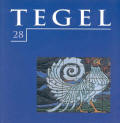 bevat artikelen over de volgende onderwerpen:
bevat artikelen over de volgende onderwerpen:
Een Mamlukse tegel in Otterlo
Agnita van 't Klooster en Hans Theunissen - page 4
The Dutch Tile Museum collection includes an unusual hexagonal blue and white Islamic tile. It is described on file and in the stock list as a 16th century Persian tile. The design is a hybrid of Chinese and Islamic styles. The article begins with a survey of the Islamic influence on the production of Chinese blue and white porcelain. It then traces the influence of this porcelain, which was imported into central Asia, Iran, Syria and Egypt from the 14th century, on tile and ceramic production in the Islamic Middle East. In the first half of the 15th century in both the Mameluke and Ottoman empires (in Damascus, Bursa and Edirne), complexes were built that were decorated partly with tiles in the international Timuridic style. The tile makers were not local craftsmen but came originally from Tabriz in Iran. Clearly, the tile in the Dutch Tile Museum most closely resembles tiles of this type in situ in Mameluke Damascus. As to the date, that no comparable later examples are known indicates that this tile is almost certainly early 15th and not 16th century. Furthermore it turns out that the tile is Persian not because it was made in Persia, but because it was produced by Persian tile makers (originally from Iran), in the Mameluke empire.
Haardachterwandtableaus uit de eerste helft van de zeventiende eeuw
dr. J. Herbert van den Berge - page 12
In the first half of the 17th century there is a type of fireplace wall with pillars on either side and between them companion pictures (pendants). The oldest tiled fireplace wall dates from 1615; after 1650 this type of tiled fireplace was no longer made. However, after 1650 the pillars continued to develop independently. Most of the tiled fireplaces can be categorized thematically as follows: Scenes from Antiquity, Symbolic representations, Biblical scenes and Royalty. The Antiquity scenes depict mythological figures and people from Ancient History. Symbolic scenes depict personifications, and Biblical figures are always from the Old Testament or the Apocrypha. Royalty in these tile pictures, manufactured only by Dutch potteries, means: natural members or in-laws of the Dutch Ruling House (House of Orange).
The specific characteristics of these fireplace pictures will be dealt with in a subsequent article.
Prent en Tegel. Willem II, Mary en wie nog meer?
Kitty Laméris - page 25
Recently a tile picture with two portraits in oval borders has come to light. The picture originally comprised 24 tiles, 12 of which are still in place (ill. 2). A famous portrait tile from a Dutch private collection turns out to have been part of this tile picture (ill. 1); it was situated to the right under the man’s portrait. The large portraits depict Stadtholder Willem II (1626-1650), and Henrietta Mary Stuart (1631-1660) and are based on prints by Cornelis van Dalen (1602-1665) (ills. 3 and 4). As Willem and Mary are portrayed in 1641, the year of their marriage, the two ladies to the right of Willem are almost certainly his mother Amalia van Solms (1602-1675) and his mother-in-law Henriette Maria de Bourbon (1609-1669). How-ever, no print or painting has yet been found corroborating this assumption.
Nisvloeren met dierenvoorstellingen
Frans Landzaat - page 29
Archeological research at a building site south of Utrecht has unearthed large size 17th century tiles and tile fragments which hitherto had only been found in the area from Amsterdam northwards. These large tiles known as niche floors were used in tiled candle niches, and protruded a few centimeters from the wall. For this reason they were decorated not only on top but also on the front edge and a couple of centimeters on the sides. A total of seven niche floors or fragments have been found, which is too large a number to support the view that they are in fact niche floors. In that case there would have had to be at least seven niches in one house. Moreover the sides are not painted and there have been no finds of other tiles that one would expect in candle niches. It is therefore by no means certain that the tiles that have been discovered were used as niche floors. Some alternative application in the 17th century interior will have to be considered.
"Eneas draegt syn vader"
Wilhelm Joliet - page 33
The epic poems, Homer’s Iliad and Virgil’s Aeneid, contain descriptions of the destruction of the mighty city of Troy and the flight of Aeneas with his aged father on his shoulders and his little son by his side. This scene of the flight with the burning city in the background was a favourite subject with painters. It is also found on tiles. The story is depicted on a large tile picture, attributed to the workshop of Orazio Fontana of Urbino from the third quarter of the 16th century, which is at Quinta de Torres in Azeitão, Portugal (ill. 1). The same scene is depicted on individual tiles made in Rotterdam in the 18th century (ill. 2). In the Rotterdam municipal archives there are two model drawings for tiles with the flight of Aeneas (ill. 3). The spons (pricked stencil) of the tile in ill. 2 has also been preserved (ill. 4). The drawing for this spons is based on an engraving of 1595 by Agostino Carracci. He was copying a painting by Federico Baraccio (1528-1612).
Jugendstil tegels van de Amsterdamse Plateelbakkerij De Distel - Deel 3
Karel Nijkerk - page 37
In this third and last article on the Plateelbakkerij De Distel in Amsterdam the focus is on the pictures and various Art Nouveau tile designs for decoration of the exterior of buildings. De Distel developed a special tile product, which was never copied by any of the other Art Nouveau tile producers in the Netherlands. It was called ‘Carduus’, which is the Latin name for Thistle. The square tiles became another speciality from about 1910 onwards. The brique coloured tiles of 50x50 or 75x75 mm were covered with a thin copper-look layer. The lines of the pattern were impressed into the surface and it was then partly covered with shiny white, yellow, green or orange glaze. The designs were often geometrical, but also more naturalistic designs such as flower or insect motifs were applied in both single tiles and tile pictures.
After the end of the first World War in 1918 the Art Nouveau designs became rather old- fashioned and the ‘Amsterdam School’ architects (like Kramer and De Klerk) used the new, fancy, glazed plain tiles for application in their heavy, brick creations in the Amsterdam rivers area. The energy of the founder’s generation was gone and so time to sell the company in 1925 could only be expected.
Bibliography 1999-2000
page 53





